Text
The Pit and the Pendulum

In Roger Corman’s 1971 remake of Edgar Allen Poe’s The Pit and the Pendulum, Francis (John Kerr) pays a visit to the castle in which is sister Elizabeth ( Barba Steele) has passed away suddenly and would like to know why. Vincent Price plays Prince Prospero, the husband of Elizabeth, and he is just sick about her death. While Prospero seems to be mourning, he is not giving up the truth to Francis about what has happened . With the help of Prospero’s sister Catherine( Luana Anderson) he is able to uncover the truth.
Now we cannot simply speak on a Roger Corman film without talking about COLOR. I feel this is such an important thing for Corman to do because Poe wasn’t able to bring his visions to life like this. Poe tells stories of a dark and unruly time , Corman seems to make it his duty to not only keep it that way but add color into it which makes it even better.

In this movie specifically, blue reoccurs more often than others. Blue can signify coldness of death and bitterness of the circumstances. Blue often comes about around Elizabeth signifying her deathly presence ( or so we thought)
Prospero character is usually the one who is up to something but for the first time, this is not the case. I like the fact that overall Corman took a stance with Prospero’s character and said “ THIS is why he is the way he is”. In previous movies it just seemed like this was a mad man who couldn’t be stopped but we were given reasoning why he did what he did. Poe as well probably left it up the reader if they wanted to forgive him for what we witnessed him cause. It makes us think : Does one person’s hurt justify the other’s? Below you can see clip of us not only getting the first time glimpse of Prospero’s past but the present showing.
youtube
The dream/flashback sequences were also very different in the movie. I was not able to find the clip from the movie but there is a scene where Prospero is telling the story of him and Elizabeth and its in very interestING blue ( cold death) that fades to violet. The use and this colors and what Prospero is talking about is almost his way of pleading he didn’t do anything to them and to an audience from watching him in previous movies “ LOOK! LOOK AT HOW I TRIED TO DO GOOD AND WHAT THEY DID TO ME” . For me, it makes me feel more empathy for Prospero rather than sympathy. Either way, two feelings you never thought you'd feel for him.

Corman was no stranger to reuse of settings and props. In this 2006 Sense of Cinema article, the writer talks about Corman's choice of locations and fiming over all
At first, Corman worked quickly because he couldn’t do it any other way; he started out with six-day shoots, and became a master at pushing his cast and crew through as many as 50 setups a day. Later, when he had longer schedules on such films as The St. Valentine’s Day Massacre, which he shot at 20th Century Fox, the amount of wasted time and money sickened him; why was all of this taking so long? Since the first take was likely to be the only take in an early Corman film, his actors poured themselves into their roles with manic frustration; unless the mike boom dipped into the shot, or the wall of a set collapsed, Corman would simply print the shot and keep moving.
This sort of “guerrilla” filmmaking instinct led him to create some of his most deeply passionate and personal works, such as The Intruder, discussed below, which examined in minute detail racism in the American South in the 1960s. Corman and his crew decided to film the entire project on location, and were met with death threats, kicked out of numerous towns during filming, and finally got the footage they needed when they told the locals that the ultra racist protagonist was the hero of the film, a notion the local townspeople applauded.
In his early days, Corman never bothered with permits when he could simply go out and shoot the film on location, leaving before the police arrived. He also pioneered the use of union crews on low-budget films, figuring correctly that the end result would have a high polish, even if the money was used up so quickly that all he could afford was one week of shooting. This gives his films a raw immediacy that holds up well today, now that most of his work has been released on DVD, with copious commentary by the director, who clearly takes his work seriously, and a plethora of extras.
When i really thought about it Corman didn't need much for wardrobe. He used almost medieval style garments which no one was checking for or often men would have long jackets with a belt tied around. Vincent Prince seemed to be the only one with character in his clothes. He was always draped in beautiful garments with jewlery that stood out . Corman most likely invested a lot into Prince Prospero because he was a character that was WORTH IT. He as well had a $300,000 budget for this movie but honestly.. you can’t tell .


For women you can see he focused a lot on beauty
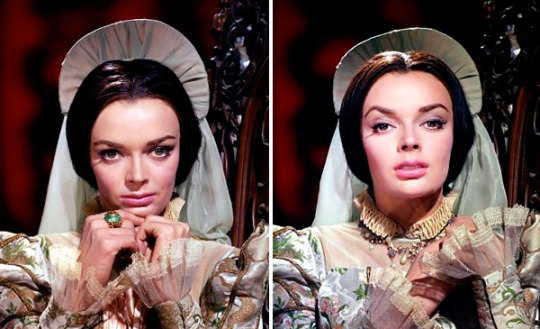
In conclusion, Roger Corman does an excellent job of telling Poe’s stories. Vincent Price has perfectly executed the character of Prince Prospero to the point where you feel wraith of whatever is happening in the movie as if you are there too.
0 notes
Text
Tree’s Lounge

In Steve Buscemi’s 1996 Tree’s Lounge , Tommy (Steve Buscemi) plays an alcoholic at his local bar who just can’t seem to get anything right. He loses his job after gambling his bosses money and is out of work. He takes a job at the ice cream parlor where he is accompanied by underaged Debbie ( played by Chloë Sevigny). Steve goes on to try to pursue something with Debbie despite her being underage and her father actually finds out and goes to town.
Just from seeing Buscemi in other movies, i at first thought this was going to be more of a comedy but it’s more of a story of his life. Buscemi is often in front of the camera and not behind it so in Interview magazine article titled NEW AGAIN: STEVE BUSCEMI by Brooke Smith, he talked about directing.
SMITH: Did you enjoy directing?
BUSCEMI: Sometimes. A lot of times I would get stressed out. I wished I’d had more time, because once I started to get the hang of it, the shoot was over.
SMITH: Was it hard directing yourself?
BUSCEMI: It made it harder for me to keep my eye on the whole thing. Like, in the party scene, where we had a camera on a dolly going back and forth catching Chloe [Sevigny], Bianca [Bakija], [Mark] Boone, and me smoking a joint, I felt stoned even though we weren’t smoking real pot. And it just felt out of control, like no one was directing the movie. Meanwhile everyone was asking me questions that I had to try to answer. We didn’t cover the scene that well, but we did a lot of takes, so I had enough to choose from when it came to editing. Another night, Boone and I were shooting a scene in a car, and the prop guy didn’t have time to put water in the beer cans, so I was drinking real beers. I had a great time, but I don’t know how good I was as a director that night.
I thought this was interesting because the movie didn’t appear like it was his first time but you can definitely see where he would need work. It’s also cool to hear what really goes on behind the scenes on movies sets with props and everything.

Tom throughout the movies tries to play the victim a lot but he is the father to everything that has happened to him . He has a self destructive tendency to think “ If this didn't happen then..” and then go on to do things that lead him up to the point that he’s at. He contradicts himself a lot throughout the film and below you can see when’s talking to Debbie .
youtube
He doesn’t want to be a loner but he is forced to because the way has to began to carry himself.

Their wardrobe choices seemed like they were very to the point which would make sense with a 1.3mil budget. Tom only wearing button ups and slacks to fit the part. Debbie is the only one to seem to have some type of effort in the choosing of clothes which most likely having to relate to her image of being “ flirty”
In conclusion, Tree’s Lounge was a interesting project to see from a actor who is usually behind the camera.
0 notes
Text
Feature Post #1: The Immigrant

In Jame’s Gray 2013 The Immigrant, Marion Cotillard plays Ewa Cybulski and Joaquin Phoenix ( Bruno ). Ewa and her sister Magda are coming to the US and while traveling, Magda falls sick and cannot cross the border with Ewa. They are forced to separate where Magda will be kept at the hospital and treated until/if she gets better. Ewa gets lucky to get Bruno to take her in where she eventually becomes a show girl. She is not at all happy for this but she must get money for her sister.
I at first picked up the reasoning behind the movie was to show an immigrants struggle in America. While this holds truth it’s not the full truth. Throughout the movie you can see Ewa’s constant fight to stay true to herself and the goal that she came for but it slowly tails off. While she is still getting the money for her sister. once seen that she’s able to get by, she fully conforms to being this call girl.

This reminded me a lot of Ripley’s character. He at first went to paris to find Dickey but he got some caught up in that, his whole agenda was thrown off. Ripley was definitely more manipulative and over the top once he got comfortable than Ewa but they were both faced with the same struggle.

They are both faced with situations of getting a whole other person where they're “ suppose “ to be under critical circumstances . I feel that they are so busy trying to save someone, they lose their selves in the process. Both movies make you think about how certain situations can you make you act different or is this a suppressed thought? Ripley seemed to be more of the suppressed thought honestly while circumstances made Ewa act the way she did.

Ewa seemed to have fallen victim to wrong guidance just like Johnnathan in American Friend. Jonathan wanted clarity on his health so bad he had conformed to the killing before he even knew it. The doctor having his own agenda caused the whole chain of events happening after the train station. Bruno was a double character . He would be all for Ewa but in the same conversation speak down and get mad. He seemed to be a symbol of America for immigrants : the good and the bad.

In conclusion The Immigrant, tied perfectly into theme of unreciprocated loyalty that seemed to occur in the movies we’ve watched
0 notes
Text
Feature Post #2: Phoenix

In Christian Petzold’s 2014 Phoenix, Nelly played by Nina Hoss and Ronald Zehrfeld plays Johnny Lenz, are a couple living in Nazi Germany . Nelly is captured by nazis where her face is dismantled and she has to undergo surgery that leaves her beautiful. Nelly finds Johnny but he of course doesn't recognize her but still takes an interest in her. Nelly goes on to pretend to be someone else while trying to get to the bottom of Johnny’s heart to see if he betrayed her.
Just like the movies we watched previous to this one, there is a constant theme to confirm or fully be someone else. Nelly just wants to practice her beliefs and be with the person who she loves but she can't do that, Stevens in Deep Cover just wants to be a cop or Bobby literally just wanting to mind his own business. I think this is a versatile theme that directors can use because while the stories themselves may not be true, the overall concept applies to everyone.


In both phoenix and we own the night both characters are rooted in loyalty to someone or something. Nelly has her loyalty to herself and getting to the bottom of whatever has happened . Bobby has his loyalty rooted in his family no matter what the past is.
Corruption keeps the ball rolling in these movies. In Phoenix the corruption is caused by the government which causes the characters to be limited to do certain things and can’t see them in different settings.This adds to the suspense of the movie because it’s like its illegal for the character to exist so anything can happen at any time. Deep Cover and We Own The Night have more of a hidden drug corruption so you can kind of gauge how the story is going to end.
I can see how both Petzold and Gray did want the movies to be action packed . There is a lot of fast camera moving that will eventually ease off . Theres a use of wide angle shots because i feel that it is important, when telling stories like these you get as much as external detail as possible.


While Phonenix has more of a stable camera, we own the night had a very unique way of showing their scenes. I like to point out the scene in we own the night where Bobby’s father is about to be shot in the car chase; because i have never seen a action scene carried out like this or even the way the camera shot. It was like the perfect disturbance and trembling to the camera. I cannot find if there is an exact term for this.
In conclusion, Phoneix shows a lot of similarities to the other films we have watched once you take a deeper look into it.
0 notes
Text
Feature Post #3: Tokyo Story

In Yasujirō Ozu’s 1972 Tokyo Story Shukishi (Chishu Ryu) and Tomi (Chieko Higashiyama) are an elderly couple who wants to take a trek to visit their children and as well as their sons widow. While the two are able to stay with their children , there's no connectedness but with their daughter in-law they are showed the upmost kindest and respect.
The first thing that i feel like is important to discuss on this movie is going to be the dialogue. In a lot of Japanese cinema, they don’t have a lot of actual talking going on if any. There are often times in the movie where there is no talking and you have to pick up clues slowly based on what the character is saying. This adds to the overall movie because it is based on treating family right and i feel like that's something that's always being pushed in our daily lives so rather than us keeping hearing about it, Ozu shows us this scenario.
The differences in how both directors portray the same overall concept is expressed in two ways. McCarey characters are a middle class white family living in the US. Their downfall comes from the depression which is rooted in money and that is their ultimate reason as to why they HAVE to stay with their kids. I do feel as if money wasn't the issue, McCarey would have no story. US is a very individualistic country and everyone knows people are selfish for the most part its a duty/burden to take care of elders. While on the other hand, Ozu focused on culture playing a role. In a more collectivist country, it’s in their Japanese Custom to take care of the parents without thought. It almost like its second nature. I found it interesting in both movies the parents used the line “ I don't want to intrude” . It seems that by default, we feel like we’re burdening someone when asking for help or in tokyo story, just paying a visit.


In the overall demeanor of the kids in Make Way For Tomorrow, you can immediately tell they aren’t interested in taking care of the parents except for George. They off bat have excuses as to why they can’t take care of the parents. Barkley and Lucy knew even before bringing it up to their kids how it would play out , hence why Lucy actually played her part in the movie so well. In Tokyo Story, Shukishi and Tomi kids prepare their homes right away. There is one scene where their daughter Shige (Haruko Sugimura) is telling her son to move his studying and he replies “i won’t have enough room” but still sends him along . I think this is interesting he says he won't have enough room rather than ANY room and it shows the difference in the children : Tokyo Story children make space for their parents rather Make A Way thought their parents would be taking up space. Another part of the contrast in kids are that the kids in Tokyo Story make group decisions that aren’t based on self-interest ( within reasoning ) while Make Way For tomorrow, EVERYTHING that comes out of their mouth has to benefit them and nothing is really for the greater good of the parents. While Tokyo Story didn’t always HAVE time, they made time and at least waited until the end to leave.
The parallel of Gerorge and Noriko characters are something to note. They both seem to be the only ones who are actually invested in helping . While Noriko isn’t related to Tomi and Shukishi, she still goes out of her way to do everything she can for them. Even Shukishi after Tomi’s death. I do feel that George and his family would’ve kept helping if they didn’t have their hands full with their daughter. They actually wanted to help but the timing and circumstances seemed to permit them.

You can see in wardrobe choices, Tokyo Story had a lot of culture influences


Tokyo Story used landscape/wide camera angles very often to show the beauty of the scenery but the camera is in the same place for majority of the movie, maybe moving once.

Rather in Make Way For tomorrow they focus on single panel and close up shots

In conclusion, Yasujirō Ozu and Leo McCarey were able to tell a relevant story majority of us will go through and affectively get their own visions across in the process.
0 notes
Text
The Hunger

In Tony Scott’s 1983 The Hunger, John ( David Bowie ) and Miriam ( Catherine Deneuve) play a rich 100+ year old vampires. Whole Miriam continues to thrive, John is slowly detonating away and meets with a mortal doctor Sarah ( Susan Sarandon) who doesn’t take even his condition serious. In a sense John sets up Miriam to find a new lover because Susan comes to their home searching for John but he has unfortunately passed away. Susan and Miriam began to bond and ultimately do a little too much bonding and Miriam turns Susan into a vampire.
The beginning of the movie was for the most part to me overwhelming. The very loud rockstar music and the constant switching of the camera kinda makes it hard for you to concentrate on what’s happening but it stables out for the rest of the movie. The camera angle doesn’t change too often in the movie actually. Scott seem to keep a straight forward/wide angle shots throughout. Colors in the movie seemed to be washed out to add to the gloomy feeling of the overall plot.


I also noticed Scott really liked to use close shots paired with landscape . I felt like he might have wanted to do this to show people not only the seriousness of whatever is happening to the person and then as well as the area around them.
Another point i’d like to touch on is the significant meanings that the movie had behind it. Apart from it involving vampires, Scott appeared to want to focus on the AIDS epidemic that was taking place. You can see Scott putting this to work in John’s character with him fading away so rapidly after he found out he wouldn't be living for much longer.

Another subject that Scott touched on was sexuality. During this time it was still a lot of pressure on people to confirm to the heterosexual norm but it wasn't as frowned upon to LGBQT previously with more people coming out. Miriam and Susan being bisexual vampires adds more uniqueness to this film which is a key competes in any fable story to keep it from being TOO much like a vampire story.

In a Cleo article written by Collen Kelsey The Bourgeois Out for Blood: Catherine Deneuve in The Hunger ,she talks about how people perceived the movie
A critical and commercial flop upon release, The Hunger found cult status in its afterlife, in part due to the film’s hyperstylized mise-en-scène, serendipitous casting, and an opening scene with goth icon Peter Murphy, frontman of Bauhaus, performing the band’s 1979 single “Bela Lugosi’s Dead.” Scott’s follow-up film Top Gun (1986) thrust Tom Cruise and Val Kilmer into 1980s macho action stardom, and went on to become a Hollywood classic in the genre, putting Scott’s directorial career on the fast track. However, The Hunger, which rounded out its cast with an on-the-rise Susan Sarandon and a post-Let’s Dance pre-Labyrinth David Bowie, is remembered more for its camp eroticism and devilish ambiance. Bowie and Deneuve, as vampire lovers John and Miriam, are initially presented as equals in their partnership. The first glimpse of the pair shows Miriam’s predatory gaze, fragmented behind dark cat eye-sunglasses, a cigarette to her immaculately painted lips, zeroing in on potential victims. Together, they proposition a couple in a smoky, laser-lit nightclub for a supposed partner sex swap. After a few cocktails and tame foreplay, the swingers are eviscerated and discreetly disposed of in a furnace.
In the beginning of the post i talked about the opening scene not really doing the overall movie really justice because it starts out really hardcore and tails off into a different story. After just making that comment, A question of Scott may have wanting that arises. Could it be his way of showing us how bad pleasures in life is? Starts off really strong and just tails off to something you never even thought it would be.
In conclusion , Scott did a excellent job of creating a movie that was not only entertaining but informational for the people around him. He was able to affectively talk about multiple crisis that still hold truth to today.

Sources:http://cleojournal.com/2015/11/24/the-bourgeois-out-for-blood-catherine-deneuve-in-the-hunger/
3 notes
·
View notes
Text
Blood on the dance floor : Only Lovers Left Alive
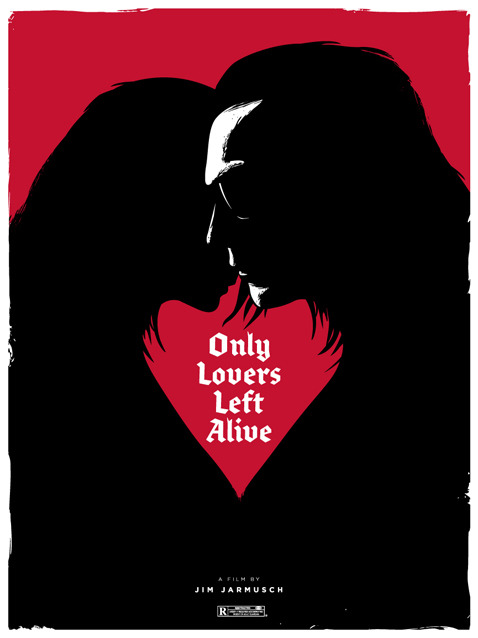
In James Jurmusch 2014′s Only Lovers Left Alive, Eve ( Tilda Swinton ) and Adam ( Tom Hiddleston ) play vampire lovers who seem to be searching for more than blood. Tom is a rockstar who can’t seem to get back into the groove of doing things. It is not directly said in the movie but Tom shows clear signs of depression ( or is it just vampire behavior?) . Eve decides to travel from paris to detroit to comfort and try to get him out of his funk. Everything appears to go smoothly until Eve’s younger sister Ava ( Mia Wasikowska ) shows up causing a ruckus and ultimately killing Adam’s friend Ian (Anton Yelchin). This results in Adam moving to Tangia with Eve where Adam does respark his love with a new instrument but due to their wise vampire friend Marlow (John Hurt), they are without blood and finally park-take in vampire festivities.
I would first like to start off by talking about the production of the movie as a whole. The use of birds eye view/overview camera angel is immediately established at the opening scene.
youtube
This angle is formally called Aerial shot and is used when directors want to establish not only the character but the world around them. In this scene Jurmusch appears to use the angle to give us some indirect characterization of the two: Eve is surrounded by books and draped in a robe signifying she is probably the knowledgeable and spiritual one and Adam is surrounded by music and instruments so he may be the creative yet “ troubled” one. Showing how both worlds come together. The music that is being played ( “Im going down down down, my head is spinning around and around”) also goes along with the angle shot and helps establish that there may be conflict for the characters together or apart.
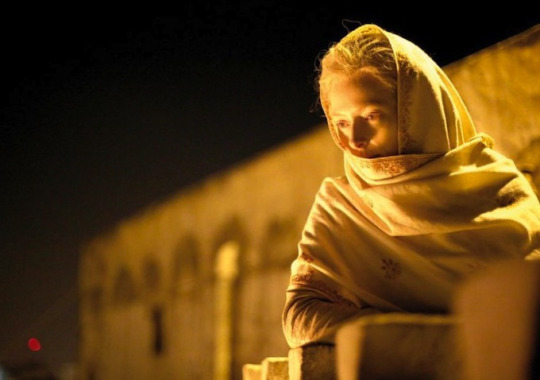
The fact that the writers did as best they possibly could to not make this a cliche vampire movie is worth speaking on. Throughout the movie, they don’t seem interested in being the regular vampires and overall have a moral compass. Often in vampire movies you see them blood sucking anyone what comes in contact with them but this doesn’t seem to be the case for them. I thought it was interesting that they didn’t kill someone for blood until the end of the movie. Adam critiques humans a lot to Eve but when encountering with them , he still humanizes them & himself carries on like one. There was an actual conflicts in this movie that wasn’t tied to being a vampire. Like i spoke on earlier, Adam had shown clear signs of being depressed from his music. He often blamed on the human’s for the feeling but i truly do think it may have been him being a vampire.
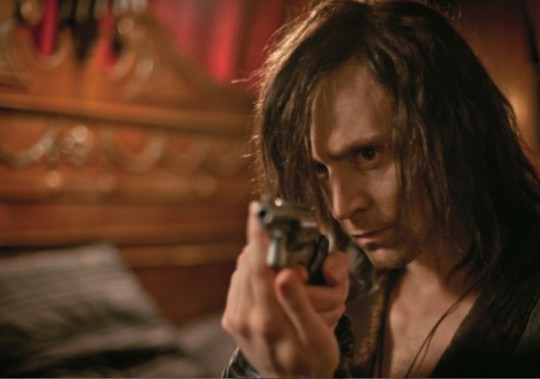
Could it be the fact that he’s been alive for centuries and his love for art isn’t as strong as it was? New artist emerging and he can’t take it? Eve makes a very interesting comment to Adam saying “ How do you live so long and still don’t get it?” I seen this as a potential theme because it eternal life doesn’t mean eternal knowledge or even the fact that no matter who or what you are in this world, you’re still going to be trying to figure things out. Adam scolded humans for not knowing but in actuality, he was looking in the mirror and maybe he wasn’t so different as he thought. The tangents can go on just from those thoughts alone. This is what makes the movie unique with the fact that you kinda have an idea of what’s going on but it’s left up to you truly to decide what it is.
Another thing to note wardrobe choice. In the Jenni Miller article Q&A: Costume Designer Bina Daigeler on Only Lovers Left Alive Vampire Costumes, Dressing Tilda, & More , she was able to sit down with the costume designer
What sort of ideas did Jarmusch approach you with about the costumes — what did he want them to look like, what did he want to avoid?
I think he was looking for something [without a] specific period, with very simple and clean lines. At this moment, the vampires don’t really care about the clothes, you know? They lived [through] that in all other periods, so they [wear] something very simple but protective … On the other side, of course, they are like animals. They have their second skin with their clothes, and that was a little bit my idea — that it’s like the second skin they got during so many years of living. They’d already lived all the fantasies they could live … so it could be something very, very simple.
I thought the part about them already have lived their fantasies was interesting but i do feel like their color choices did play a role While in Tangia, you can see Eve wearing nice garments but once he comes to detroit , she wears the same white often and Adam wears all black. This could be signifying Eve bringing purity and life to Adam’s dark time
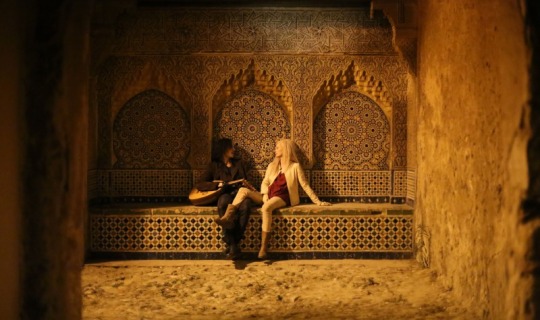
Overall, Jurmusch does an amazing job of telling a modern and far-less stereotypical vampire story
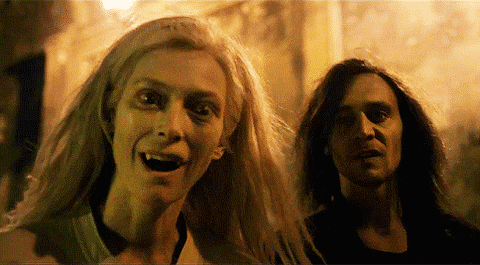
Sources: https://www.thecut.com/2014/04/vampire-costumes-of-only-lovers-left-alive.html
picture sources: https://giphy.com/explore/only-lovers-left-alive , https://www.google.com/search?q=only+lovers+left+alive&sxsrf=ACYBGNSO1hopynwwf7aDGC37EFDJmPPQQA:1576174702991&source=lnms&tbm=isch&sa=X&ved=2ahUKEwju9pmq3LDmAhXVbc0KHS2LAFsQ_AUoAXoECBYQAw&biw=1280&bih=672
0 notes
Text
Make Way For Tomorrow
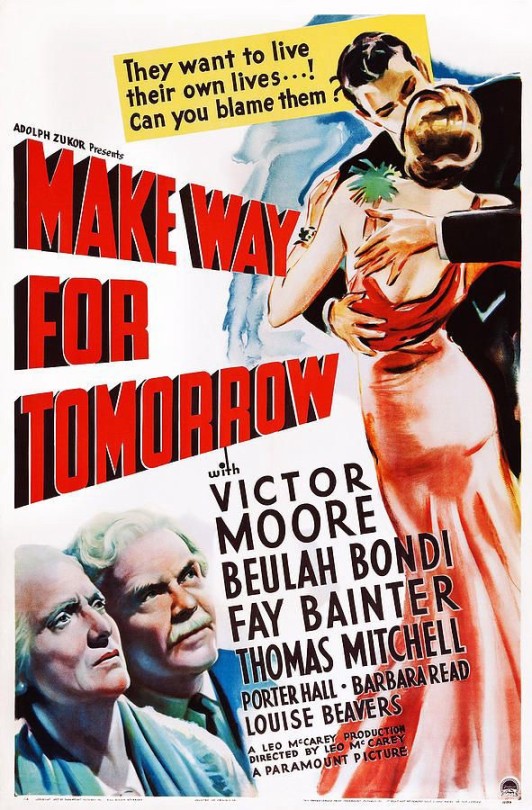
This week i will be discussing Leo McCarey’s 1937 Make Way For Tomorrow . In this film Barkley played by Victor Moore and Lucy played by Beulah Bondi are an elderly couple who’s house is going into foreclosure and they can no longer stay in their home. Faced with this delima they ask their 5 children to help them find shelter. The children don’t take too much fondness to this and appear standoffish . Their brother George is the only one who takes the initiative to help the parents splitting mom to his home with wife and daughter then dad with Nellie played by Minna Gombell. Lucy is treated well by George but runs into hiccups frequently with the wife which causes them to become uncomfortable. Barkley takes sick for some time and it is overall hard for the couple being away. Throughout the movie they fight in their own ways to get back to each other and on their last day before Barkley going to California, they take a stroll down memory lane.
I was at first confused on the overall purpose of the movie but when i thought about the great depression, the message became clear. To us in this time this can be viewed as a old film that tells a story of just an unfortunate cute old couple but to people back in this time , it was their lives. With the depression and everything that followed, people weren’t sure of what was going to happen next and they were force to go with the flow even with things in pieces in hopes that they would be brought back together again even if that meant family. Although there isn’t many clips from the movie that you can find there is one scene in particular that stood out to me. In this scene, Barkley calls Lucy for the first time and at first they’re so excited to speak with each other and the call slowly turns said and very errier because you can feel the love that they want to be able to express but can’t because they’re far away from each other.
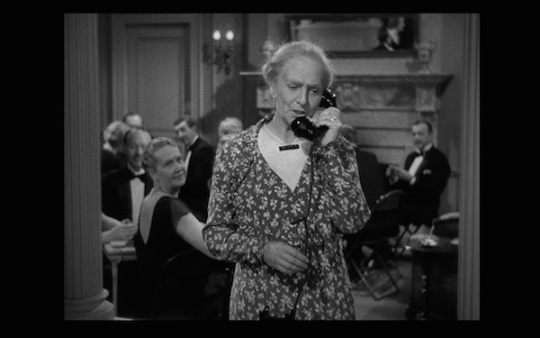
As i mentioned earlier, George appeared to be the only sibling that ACTUALLY wanted to help. He was the first to offer to get something done with the living situation and even got Nellie to agree. Although it was clear that him and his family were happy to have mom there, there were clear moments when you can see it was becoming an issue. Anita( Fay Bainter) became irritable within reason when Lucy appeared to be wanting to “run the house” in many ways. One of the important ways being raising her daughter Rhoda ( Barbra Read) when she goes missing with a older man and now they have to find her. In this particular scene Anita was infuriated with Lucy and began yelling at her but quickly stopped because Lucy had obviously been very apologetic. This all made me think of the strain that the depression placed on people. Although these people who appeared to have had great relationships before moving in with each other , were slowly being torn apart by little situations building on each other
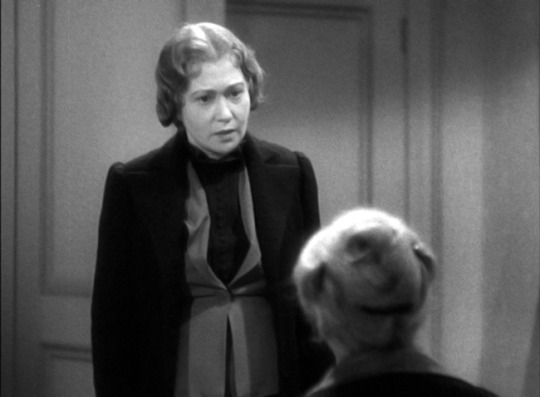
Even if these people were family, it placed a lot of burdens on everyone involved. In this case the parents being housed is the burden of the children but that (being housed) & everything that comes along with it is the burden for the parents. Nellie, who doesn’t even follow through has a burden of her husband not agreeing and then as well as her not being interested in it at all.
Even if these people were family, it placed a lot of burdens on everyone involved. In this case the parents being housed is the burden of the children but that (being housed) & everything that comes along with it is the burden for the parents. Nellie, who doesn’t even follow through has a burden of her husband not agreeing and then as well as her not being interested in it at all.
In the criterion May 11th article Make Way For Tomorrow: Make Way For Lucy the writer touched on a great point
In Make Way, Anita's continual reactions draw us in because they compel us to figure out what a face means, to discover a telltale gesture barely hinted at, and in making this effort, we are converted from passive watchers to offstage prompters. Half-expressed emotions oblige us to complete the thoughts. Similarly, we feel complicit when (six times in Make Way) two people make faces behind the back of a third; we take sides in the game. Or when we sneak with the maid to a keyhole to eavesdrop—and still can't find out why granddaughter Rhoda didn't come home, or what the phone call was, unless we happen to catch a throwaway line three scenes later (“Mrs. Clare promised to keep Rhoda's name out of the case”), and even then we have to chew on it. And we have to chew again to figure out why daughter Cora is so upset that Max brings her father soup. (She's like Cary Grant in McCarey's The Awful Truth, who accuses his wife of adultery: Cora doesn't make soup, and Grant's had an affair
This part stood out to me because throughout the movie Lucy had very interesting looks on her face. I thought she might have been playing them the whole time and some time’s she wasn’t but then i realized she was perhaps getting by the best way she knew how: being herself.
The overall relationship of the parents were very interesting. The movie can take so many turns: are the the kids even shadier than we think? will the parents get back together? does something bad happen? But to my liking it turned out to be a nice trip down memory lane. The parents finally reuniting was something interested because it almost signified a main question during the great depression for some “ Will i ever see my loved one again?” Some got the answer they wanted and other’s didn’t.
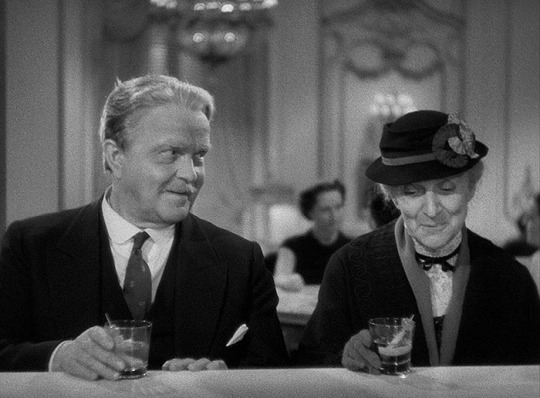
This trip down memory lane has many things going on. First they’re basically looking back on everything they should have done while time is not in their favor. Yet they are determined to spend time with each other.
https://www.youtube.com/watch?v=k4mePNnTsQk
They had finally been able to take their time back and do what they use to do. All while their children are waiting on them.
In conclusion, McCarey was able to catch a beautiful couple in a not so beautiful moment to result in a cinematic master piece.
Sources:https://www.criterion.com/current/posts/1377-make-way-for-tomorrow-make-way-for-lucy
Pictures:https://www.google.com/search?q=make+way+for+tomorrow+1937&tbm=isch&sxsrf=ACYBGNQjuiWkPisVg1JD5Hol-s9-hdPOJg:1573158262014&source=lnms&sa=X&ved=0ahUKEwjFxIeb99jlAhVRF6wKHV6gB9kQ_AUICygC&biw=1280&bih=672&dpr=1
0 notes
Text
BLACKkKLANSMAN

In this week blog i’ll be speaking on Spike Lee’s 2018 BLACKkKLANSMAN. The movie takes place in Colorado Springs and Ron Stallworth ( John David Washington) is the police departments first black cop. Throughout the moving Stallworth battles with constant racism from not only the citizens but the department. Stallworth wants to go undercover and is assigned to a case to at first, spy on the Black Panther party meetings, in which he meets the leader Patrice who is played by Laura Harrier and began to have feelings for her. The case turns into Stallworth wanting to expose the KKK and goes undercover as a white man, Adam Driver playing Flip Zimmerman is used as a decoy for meeting with the klan.
First, i would like to speak on the intro itself. I thought it was interesting because after finishing the movie, i felt that this set the tone for it. Throughout this clip you can hear the actor stumbling on his words and constantly having to ask what correct words to use. It made me think think do the racist who think like this actually know what they’re talking about? It appears this is like a scare tactic to get white people to be against integration but he just seems to use really offensive language and discombobulated . I felt he set the tone for the other white characters in the movie because they all seem to be blabbering about nothing. They are often so full of hate and anger that they can’t even get their words out and it’s truly seem as comical . They have to scheme and meet in secret places much like children because although they feel their reclaiming their land, which isn’t even their’s to claim, consciously they know it’s hatred towards black people. They pin black people as the animals but in fact, they are the one’s with crosses on fire and red skin.
youtube
Stallworth as a character for me, was interesting and relatable. I thought his overall character was peculiar because Throughout the movie, he always had to be two people for someone. For Partcia and his black friends he had to be a brother but for the department he had to be a white washed version of himself or not even himself at all. There was always a push for him to conform who he really was. I felt as a black person myself, it shows one of the rawest experiences of being black and although it may be a movie, it still holds a significant amount of truth. As a character, you can see Stallworth isn’t too phased by it in scenes like when he ask the chief to go undercover and immediately he proceeds to tell him he will cut off his afro to look more clean. The chief never said anything but Stallworth knew that just something as simple as that can “make a difference” simply because he’s a black man in this setting.

Deep Cover and BlacKkKlansman have a lot of similarities in the overall movie but i see deep cover as a more noir film rather than this one being more of a new age Neo noir. Deep cover pleases more to the red lighting to show the corruption going on throughout the movie while Blackkklansman only shows it in the beginning scene. Deep cover seems to expose more corruption than racism.
Both men appear to have to conform to the world around them due to their skin color but the baseline of them both is that they just want to be cops. They are both painted as the poster child for the issue and although they are in the circle , they are still treated poorly by majority of their peers. Although they both take place in later time, they show different versions of the experience. For example, the characters in deep cover are more uptight and serious with their corruption but in blackkklans men they’re almost making fun of the subject with the characters being rather comical at times than serious.


In the 2019 Deadline article Oscars Last Call: Harry Belafonte & Spike Lee On That Bone-Chilling ‘BlacKkKlansman’ Scene the writer got a chance to sit down with Harry Bellafonte and speak with him regarding his scene from the movie :
DEADLINE: He is one of those guys who leave you with a smile on your face when you’ve spoken to him, and makes it hard to stop talking to him. Here, you read the script. You’ve been through so many times in your life that seem far more volatile than the one we’re in now. Why was it important to play that role which vividly reminded us of the historic relationship with racism that has symbolized a KKK that has reared back up?
BELAFONTE: It is my firm belief that the issues of race are a blight on American history, and needs to be told as often as possible. The truth of the matter is, all this racial stuff is not a thing of the past. It is very much a thing of the present. When you start shooting down kids like was done in Florida, and doing what is rampant in the culture of American violence, any chance you get to make a statement and expose it, it’s very important. Nothing could be more evident to the validity of that than what just happened to [Empire star] Jussie Smollett.
I find this section of the article interesting because it 100% true. For some these movies are a quick trip into the past but it is the present for most. As much as people want to hide this part of history and plague it as only a hiccup, it is far more complex than that. We should encourage more movies and stories like this to be told because as long as the hate is relevant, the power to change it needs to be as relevant.
Below is a chilling scene by Harry Bellafonte on the murder of Jesse Washington
youtube
In conclusion, BLACKkKLANSMAN told a “perfect” story of the real hatred and racism in America. It lets us not forget this plague of hatred that is relevant than it has ever been and reminds us that 50 years ago was just around the corner.

Sources: https://deadline.com/2019/02/harry-belafonte-blackkklansman-spike-lee-oscar-best-picture-race-1202555420/
Photo sources:https://www.google.com/search?biw=1280&bih=672&tbm=isch&sxsrf=ACYBGNTXbPZbsmJa_jQaGV6gSguYCTMV7A%3A1571933489075&sa=1&ei=Mc2xXfOCBIzIsQXHvKrYCw&q=blackkklansman+patrice&oq=blackkklansman+p&gs_l=img.1.2.35i39j0l9.12287.12620..14038...0.0..0.118.220.0j2......0....1..gws-wiz-img.......0i67.RSooWq3isIQ#imgdii=7sLx16Cj3WFj1M:&imgrc=zqbHUBzNQGpUUM:
1 note
·
View note
Text
We Own The Night

In James Gray’s Own The Night, Bobby Green ( Joaquin Phonenix) plays a night club owner who is seen as somewhat of an outcast from his brother Joseph Gruinsky ( Mark Wahlberg) and his father Burt Gruinsky ( Robert Duvall) because unlike them, he doesn’t share the same passion of being a cop. Bobby is presented with information from his father and brother that they would like to take down a nortrious king pen Vadim that frequently hangs out at the nightclub that Bobby manages. Of course Bobby declines and doesn’t want anything to do with the situation until Joesph raids the club without making him aware of it, in which Vadim shoots Joseph later in the movie for. Vadim later on tries blackmails Bobby into letting him move a shipment through the club and Bobby of course lets him father and brother know. Bobby goes undercover and wire to the house that the operation is taking place in to expose Vadim but everything doesn’t go exactly as planned and bobby ends up in witness protection with his girlfriend Amanda Jurarez played by Eva Mendez. Vadim later goes on to kill Burt and Bobby joins the force and goes to seek revenge. Eventually killing Vadim.

In the movie, it appears that everything that Bobby does is good for him but not for his family. I thought the whole chemistry of their family was interesting because in the beginning, they would never talk directly to each other on the issue that they had. It was either Joseph talking about Bobby to Burt or Burt talking about Bobby to Joseph even if they were in the same room. Even the two other cops , Michael and Jack, intervene often with their family arguments and nothing ever gets resolved , just a lot of yelling and anger. It often appeared that Joseph and Burt would antagonist Bobby for the littlest things but it all seemed to be tied back to them wanting him to join the force. I unfortunately cannot find the exact scene but there is a part in the movie at Joesphs welcome home party that Joseph ask his father and the two cops to step outside to talk about the case and when Burt tells Bobby to come along, Joseph get’s mad for no reason saying he’s not apart of the force and his input doesn’t matter. Even though, Bobby is the reason they’re even able to get close to their target. I felt like this was just one of the examples of Bobby being antagonized by his family throughout the first half of the movie even though, Bobby seemed less problematic as they made him up to be.

The visuals in this movie was another key point i wanted to touch on. I thought the specific angles and shots that were captioned were very intriguing and for lack of better term, clear. The visuals when they happen almost take you by surprise that it could get that graphic and you almost don’t expect it to be.The movie does appear to have a lot of wide angle shots and this might be due to the movie having a lot going on in the background of each scene so i could see the director making wide angle a prominent feature in the movie. In this scene, Bobby is undercover at the operation house where things go wrong.
youtube
In this next scene Bobby has to swtich hotels and Vadim’s men are now following them. This is probably my favorite action shots because of the camera and how it almost appears to be still but everything else is moving around it. Almost like you have tunnel vision and you can see it all happening.
youtube
The movie does appear to have a lot of hidden foreshadowing in it, or it appears to me. The scenes as well almost seem to announce themselves in the previous one. For instance when Burt talks to Bobby about him not wanting him to get caught up in the wrong life with Vadim on his side and Bobby ensures him he doesn’t desire that but the next scene Bobby and Amanda are having a drug induced party with alcohol and everything else. Another part of foreshadowing that i picked up on was when Joseph was shot and Burt made a very interesting comment of “ Are you happy now?” and i almost seen this as an omen for his death because in which, the only thing that eventually got Bobby on the force was his father being killed. Almost the writers way of asking Burt “ Are YOU happy now?”
In the Cinema Scope article Subverting the Moment: James Gray on We Own the Night by Andre Tracy, she makes a key point
The inevitability of We Own the Night is its means of illumination; it is a formal, structural, creative force. The choices Gray makes within his scenes, the tenor of the actor’s performances, the atmosphere of intimacy and quiet intensity, the shocking violations of that intimacy by sudden and striking violence—these virtues do not exist in spite of the mechanisms of the film’s outer movements, they are occasioned by them. Gray understands intrinsically that narrative is something to respond to, that the dictates of traditional storytelling models allow for choices in how they are to be handled. And this is part of the tension, and the pleasure, of narrative for the viewer: that one’s involvement in the movements of the narrative coexists simultaneously with a consciousness of how those movements are being shaped. We Own the Night holds no surprises apart from those of talented collaborators constantly choosing the movements that will create the most affecting, genuine, and expressive moments.
I agree with this quote because from the drawing board to the films execution you can see that everything was calculated down to its grain. I did like the fact that Gray didn’t have any scenes that you knew were coming. For instance i thought throughout the whole movie that Amanda was going to be the trader just by the way the director would angle shots at her in certain scenes and as well her body language but it in fact turned out to be Bobby’s best friend J. Gray’s creative eye help keep me not only locked in but action stimulated.

I would like to point out Joaquin Phoenix as an actor. I did not all expect this role due to seeing The Immigrant (2014). Movies like these two once watched can show his diversity as an actor and then as well some consistency in the characters that he plays. It appears that he is a victim yes but seems to always be someone’s savior or the headman in charge. Him being able to keep that balance makes him the perfect actor for the roles in which Gray cast him in. He seems to have a tendency of zoning himself into the character and almost making you think that it’s really him. Along with Gray’s creativity as a director, it was easy to grasp the overall picture of the film without giving anything way.
In conclusion, Gray’s creative eye was able to capture an action packed yet emotionally intriguing film
Sources: https://cinema-scope.com/cinema-scope-magazine/interviews-subverting-the-moment-james-gray-on-we-own-the-night/
Picture sources: https://images.app.goo.gl/w1KwbTPG7Qd9zkZn8 , https://images.app.goo.gl/sDwBWCmXPAGpVign9 , https://images.app.goo.gl/UqUq512sBCrZtc8w8 ,
0 notes
Text
In Fair Verona: The Talented Mr.Ripley

In Patricia Highman’s 1999 The Talented Mr.Ripley, Matt Damon plays Tom Ripley who is an underdog back at his home in new york where he works odd jobs serving people until one day he is approached by a man named Herber Greenleaf. He mistakes tom for someone who his son, Dickie Greenleaf (Jude Law), went to princeton with in which Tom never corrects him of and ultimately is asked to bring Dickie back to the states from Italy. Tom spends his time in italy, with Dickie and his girlfriend Marage ( Gwyneth Paltrow ) living lavish and begins to fall in live with Dickie and his life and goes on to impersonate him throughout the film after he kills dickie on a boating trip.
The first point i would like to touch on is the reappearance of water in the film. A decent amount of the film is shot on boats in a crystal blue sea and i can see some meaning in it. In this first scene Marge is consoling Tom about Dickie’s friend Freddie having all of the attention from Dickie now.
https://getyarn.io/yarn-clip/3e1db882-b92e-4ce3-b1c9-4181b50fe274#SyXCG9e_8r.copy
It doesn’t show the full clip to where the camera wide angles to where you can see a very blue and clear rippling sea and i feel that this symboizes how just like the water, Dickie can be all for you and then you just be washed away to shore. Another scene that caught my attention was when Silvana commits suicide
youtube
Later in the movie Mr.Greenleaf makes a comment of “ Always save pain for daylight” It made me think of the death of Silvana being that anything done in the dark will always come to light.
Tom Ripley as a character himself was very interesting to me. Through out the whole movie he seemed to always be ahead of everything. He had an answer for every single questions or statement without hesitating. I feel that his clean cut demanor and nerdy charm kept everyone from assuming even the slightest wrong thing about him. This is what maybe have aided in him being who he is. He may have been seen as an underdog but mentally, he was not. I felt he was the most intelligent and attentive person throughout the film. These traits and his manipulative ways though, ultimately leaves everyone except him by the end of the film with the short end of the stick

In Emily Sear’s Cover To Credit: The Talented Mr.Ripley article, she states
“It’s almost as if Highman’s created a character far too complex to be captured in a single performance. Her Ripley is brilliant, methodical, and devious in his mission to insinuate himself into Dickie’s world. Yet at the same time, beneath the surface lies no small amount of insecurity, repressed desire, and a tremendous need for love and acceptance”.
I agree highly with this section because like i stated earlier he never showed any real emotion towards anything other than Dickie not showing him attention. He always had a blank stare on his face or was already ready with a combat if something was being said. He was always ready to be Dickie even when he didn’t have to be. He spent literal months studying Dickie and briefly impersonating him until he had it down packed and Dickie was actually dead. Even once he was VERY close to getting caught, he still didn’t stop. Ultimately trying to hold up the fling with Meridith at the end of the movie before killing yet another person.

In conclusion, Tom Ripley is by far one of the most complex characters seen in cinematic history .

Sources:
https://t.umblr.com/redirect?z=https%253A%252F%252Fbirthmoviesdeath.com%252F2019%252F03%252F28%252Fcover-to-credits-the-talented-mr.-ripley&t=ODViYWQ1MzZlMTE1OTEwNDJhNzI1YzE1YWE0MjQzZWQwMWM3ZGE5MSxkODVlN2YwMTJjNjFlNDU5NTFmZWQwN2I2MDk0MDZkNDViMjZkOTIy
1 note
·
View note
Text
House Of Usher: SHE’S MAD

In this weeks post, i will be discussing the 1960 Roger Corman remake of Edgar Allen Poe’s House Of Usher
The movie takes place in a , what at first looks like an abandoned mansion from the outside but is actually a lively house once you enter. Philip Winthrop turns out to be in love with Madeline Usher and wants to bring her back to Boston but her brother, Roderick Usher, continues to deny him access to be with her and neither Roderick or the butler, Bristol, would let him know why. Madeline eventually admits that she and her brother will be dead soon due to the plague of evil in the house due to her past relatives so she wouldn’t be able to leave with Winthrop. Winthrop still refuses to leave Madeline without her coming with him. Winthrop spends his entire 2 days dosi-doing around with Rodrick to let Madeline leave Later in the film, Roderick ends up “killing” Madeline to end the madness but Madeline doesn’t take fond of that and returns to claim her family title of evil and not only kills Roderick but the house burns down with Bristol in it shortly after Winthrop escapes.
In the film, i feel like Poe’s writing set up the perfect setting for Corman’s visual ideas. As stated in the Nerdist Article, “ His idea was to have these movies as outworldy and strange as possible “ (https://nerdist.com/article/roger-corman-poe-films-vincent-price/) Corman is able to capture the suspense throughout the film without directly letting the viewer know. The film also keeps the eyes moving with colorful rays of reds and blues to match the energy, or so i feel, of the room at that time. The opening scene caught my attention because without a word even being said, i know this house had some kind of evil arising in it , from the smokey ground to the cobwebbed fences. Another part i noticed was that characters would be there one minute and oddly disappear the next, I feel that this itself added more suspense to the movie than it already was . Where are they going? Did one of the family members get them? Are they not really there? It leaves a lot of room for imagination to wonder in which, is something that Poe was no stranger to
Lastly, from his stern yet polished look, i thought the overall character of Roderick was intriguing. At first it seemed like he was a very over protective brother with what seemed to be correct reasoning. As the film continues, Roderick shows us just how close the apple stays to the family tree but committing sneaky and malicious acts. For example, in one of the scenes Madeline’s sleeping disorder causes her to look like she’s dead but she’s actually really not. Roderick uses this moment to out smart Winthrop and fake Madelines death and decides to bury her alive. This shows us how serious Roderick is with carrying out the family’s agenda. Another part of Roderick that observed was the paintings of his evil family members that were in the home. There is one scene where Roderick is waiting for Madeline to arrive and kill him like he knew she would come to do. In the back, you can see what appears to be a finished painting of a new family member with paintbrushes still soaking . I thought this was interesting because Roderick has spoke about how you can see the evil in their eyes in the paintings but he was the one that was capturing it. It left me wondering, were those family members really that evil or was it his paintings that portrayed this evilness and kept it going?

In conclusion, Corman was able to keep Poe’s profound yet twisted narrative of the House Of Usher intake and without a doubt delivered a cinematic masterpiece.
1 note
·
View note